6
YNSA Basic Points
“Those who are well informed of heaven must be able to make corroboration [of their knowledge] in terms of humanity. There is a number 12 [for instance, months] in relation to heaven. [Therefore,] human beings have 12 channels to correspond to it. Heaven is divided into 365 degrees, and humans correspond to it with [as many] qi points.”1
“You can only go halfway into the darkest forest; then you are coming out the other side.” – Chinese Proverb
YNSA Basic points. These are the first points used to treat a myriad of diseases based on anatomical pathological correlates and positive YNSA Neck Diagnosis findings.
YNSA Basic points. The first points discovered by Dr. Toshikatsu Yamamoto.
YNSA Basic points. Found in all four quadrants of the scalp.
YNSA Basic points. Some points are lines of points.
YNSA Basic Points
The YNSA Basic points are scalp points that are all ipsilaterally, anatomically correlated. The points were originally named as Dr. Yamamoto discovered them through trial and error as patients present themselves to him in the hospital and clinic. The author further expanded on points that were found to be repeatedly relevant. The Basic points are most frequently used to treat pain in an anatomical area; they are also used to treat disease and dysfunction associated with that particular body part.
The Basic points are found in the YIN and YANG halves of the scalp and are more medial than lateral. There are 23 Basic points found in YIN and 23 Basic points found in YANG. Of the 23 Basic points, there are five Basic points that have subdivisions that are related to individual units, vertebral units, individual vertebrae, and/or parts of the appendicular system. The Basic points that are lines associated with subdivisions of vertebral units are A-1–7 cervical (e. g., A-2 means second cervical vertebra and its related structures, including the spinal nerve root), D-1–6 lumbar (e. g., D-1 means lumbar 1, D-6 means sacrum), E-1–12 thoracic, C-1 upper extremity, and C-2 lower extremity. There are three additional lines that are related to the central nervous system; M-1 represents the basal ganglia and limbic system, M-2 represents the cranial nerves I-XII and the cerebrum, M-3 represents the cerebellum. All the other Basic points are just that—individual points on the scalp. There are 15 individual Basic points in the YIN, front half of the head, and 15 individual Basic points in the YANG, back half of the head. The YIN and YANG Basic points are mirror representations of each other. The individual Basic points are: B-1 shoulder, B-2 foot, D lumbar spine, F sciatic nerve, G-1 medial knee, G-2 patella, G-3 lateral knee, H lumbar spine, I lumbar spine, J foot, K lumbar spine, and the four sensory organ points, which are named after the sensory organs, S-1 eye, S-2 nose, S-3 mouth, and S-4 ear, see Figures 1–3 and 1–4 in Chapter 1.
For example, if one has neck pain, the A point relates to cervical spine anatomy, which includes bone, cartilage, blood, lymph, nerves, and their neurological functions. Once the diagnosis is made for the pathology, dysfunction, or pain and a determination is made that the patient would benefit from YNSA, the next step is to follow the first, second, third procedures shown in Figure 5–1 in Chapter 5, and the Basic Point Diagnosis. The first step is to determine which side to treat, left or right. The answer is ipsilateral to the problem. The second procedure is to determine which quadrant to treat, either YIN or YANG. From that determination, one advances to the third procedure and decides which phase of YIN or YANG is to be treated; for example, Yin of YIN or Yang of YIN. The next problem is to find the YNSA Basic point followed by the YNSA Ypsilon point; this can be difficult at first. The Basic and Ypsilon points are always little ridges or mountains in the scalp as you palpate the skull. This psychomotor skill, as well as the needling technique that follows, is best learned one-on-one with an instructor. The companion DVD provides a demonstration of this technique for one to model.
YNSA Basic Point Protocol
Always treat the anatomical correlate ipsilateral to the pain, dysfunction, disease, or tender LI-4 he gu.
Use neck diagnosis to confirm the need for treatment. Retest neck diagnosis after needle placement in the scalp to ascertain correct needle placement.
1. Palpate the LI-4, he gu, point to determine which side is most tender. If one can not tell the difference with the patient’s help, then palpate both left and right LR (liver) neck diagnostic points simultaneously, to see which one is most tender. If one still can not tell which is most tender, then go to the KI (kidney) neck diagnostic point, palpating left and right simultaneously to see which one is tender.
2. Palpate the LR (liver) YNSA neck diagnosis point on the tender side to determine if the sternocleidomastoid muscle (SCM) is hard or soft. If the SCM is soft, treat in YANG. If the SCM is firm, treat in YIN. Furthermore, if the SCM is hard/firm, treat in Yin of YIN. If the SCM is superficial soft/hard underneath, treat in Yang of YIN. If the SCM is firm/soft underneath, treat in Yin of YANG. If the SCM is soft/ soft, treat in Yang of YANG. More than 90% of the time, it is hard, so treat in the YIN phase. Less than 10% of the time, it is soft and to be treated in the YANG phase.
3. YNSA Basic point neck diagnosis is done by palpating the lumbar, thoracic, cervical, and brain points. Tenderness indicates a positive finding and need for YNSA treatment of the correct Basic point. Follow the procedure in Figure 5–2 in Chapter 5.
Scalp and Body Measurements
All descriptions are given in Chinese acupuncture measurements, cun, because in practice it is easier to use finger measurements in determining point locations as opposed to a metric ruler. A cun is, specifically a patient’s one body inch, see Figures 6–1 and 6–2, the anatomical measurement of the patient’s middle phalanx of the index finger or the width of the patient’s thumb. By correlating your index finger middle phalanx with that of your patient, you will be using the correct measurement on various size patients, see Figures 6–3, 6–4, and 6–5. One index finger breadth is ~0.5 cun. Other measurements will be noted in millimeters (mm) or centimeters (cm).

Figure 6–1 1 and 2 cun measurements.
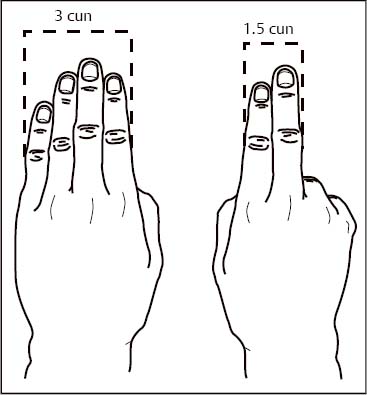
Figure 6–2 1.5 and 3 cun measurements.
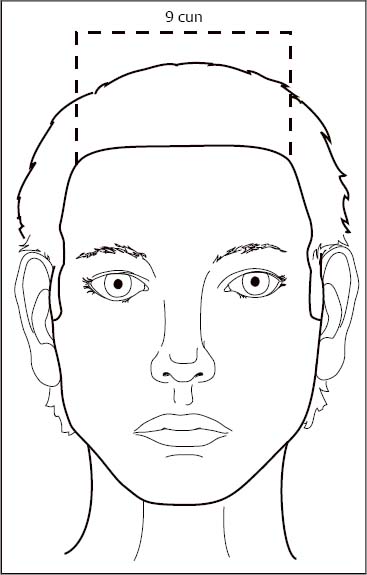
Figure 6–3 Forehead cun measurement.

Figure 6–4 Lateral head cun measurement.
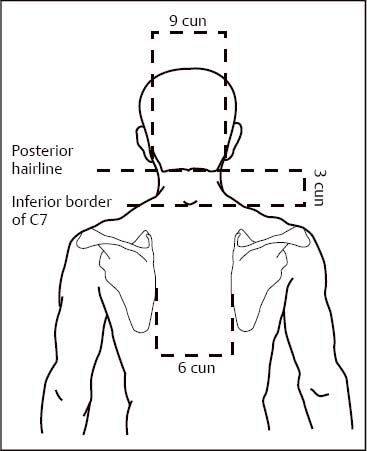
Figure 6–5 Back of head cun measurement.

Figure 6–6 Basic point A-1–7 Yin.
YNSA Somatotope of the Scalp: Basic Points
Points A-1–7
Anatomical Correlates
Ipsilateral: Cervical spine vertebrae C1–7, C1–8 nerve motor and sensory distribution affects and effects, C1–7 discs and fascia, cervical musculature, and soft tissue structures of the neck.
Location
A point is a line of points representing the entire cervical spine.
Yin of YIN: At the hairline, 0.5 cun lateral to the metopic suture of the frontal bone, see Figure 6–6. In Yin of YIN, cervical nerve root 3 (C3) is located at the hairline, cervical nerve 1 root (C1) is located a few millimeters below the hairline, whereas C8, the eighth cervical nerve root, is located more centrally (posterior) along the line of the A points, ~30 mm posterior to the hairline.
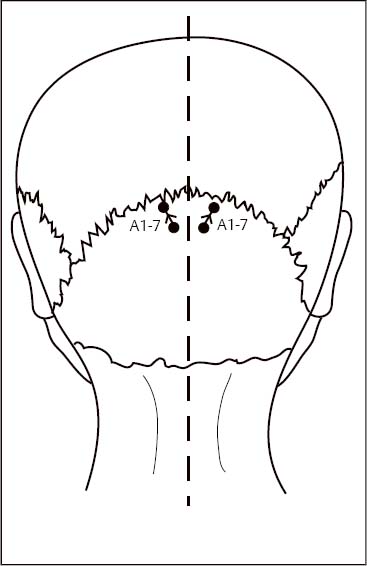
Figure 6–7 Basic point A-1–7 Yang.
Yin of YANG: At the superior nuchal line ~0.5 cun lateral to midline of the occipital bone, see Figure 6–7. C1 is located caudal/inferior. C8 is located more centrally (anterior) along the A line point ~40mm anterior to the superior nuchal line toward the lambdoidal suture.
Technique
Palpate the slight ridge or contraction of the areola tissue of the scalp. Piqué subcutaneously at a 70 degree angle over the representative cervical correlate. If treating more than one vertebra correlate, change the needle angle to 15 degrees, then thread the needle along the ridge.
Purpose and Use
This anatomical point is especially useful when a positive neck diagnosis is made, but may be used based on known anatomical relationships to the patient’s disease, dysfunction, and/or point tenderness. This point is effective for cervical pain and dysfunction: cervicalgia, myositis, cervical radiculopathy, tension cephalgia, migraine, acceleration/ deceleration syndrome/whiplash, vertigo, neuritis, neuralgia, cerebral disturbances, facial paralysis, toothache, and vegetative disturbances.
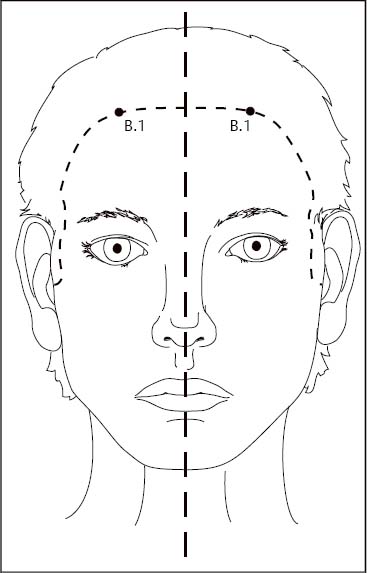
Figure 6–8 Basic point B-1 Yin.
Point B-1
Anatomical Correlate
Ipsilateral: Acromial-clavicular joint and glenohumeral joint and related soft tissue structures.
Location
Yin of YIN: At the hairline, 1.2 cun lateral to the metopic suture or 0.7 cun lateral to the line of the A points, see Figure 6–8. The point is ~3mm in length.
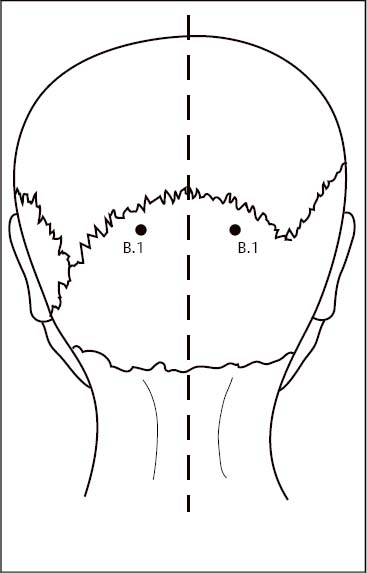
Figure 6–9 Basic point B-1 Yang.
Yin of YANG: On the superior nuchal ridge 1.0 cun lateral to the midline of the occiput, see Figure 6–9. The point is ~3 mm in length.
Technique
Palpate the slight ridge or contraction of the areola tissue of the scalp.
Piqué subcutaneously at a 70 degree angle over the point.
Purpose and Use
All shoulder joint pain and pathology, including rotator cuff pain, osteoarthritis, hemiplegia, paraplegia, tendonitis, and bursitis
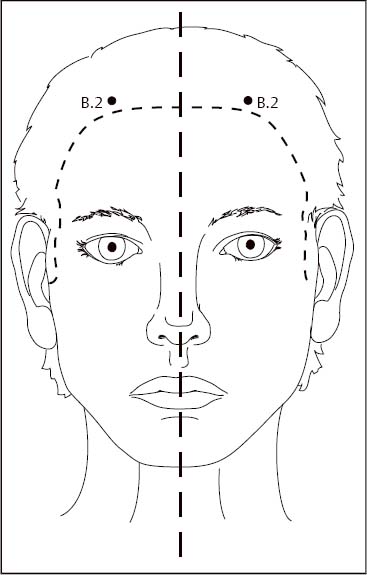
Figure 6–10 Basic point B-2 Yin.
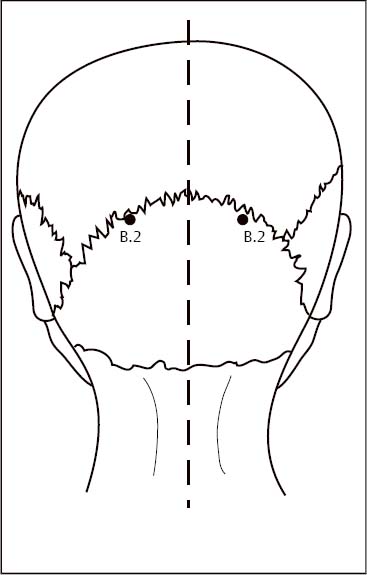
Figure 6–11 Basic point B-2 Yang.
Point B-2
Anatomical Correlate
Ipsilateral: Foot and related soft tissue structures.
Location
Yin of YIN: About 0.5 cun posterior to the hairline 1.2 cun lateral to the metopic suture or 0.7 cun lateral to Point A, see Figure 6–10. The point is ~3 mm in length. Yin of YANG: On the lambdoidal suture area 0.25 cun lateral to the line of the A points on the occiput, see Figure 6–11. The point is ~3 mm in length.
Technique
Palpate the slight ridge or contraction of the areola tissue of the scalp. Piqué subcutaneously at a 70 degree angle over the point.
Purpose and Use
Foot pain, neuropathy, neuralgia, neuritis, and dysfunction
Point C-1
Anatomical Correlate
Ipsilateral: Entire arm from shoulder to finger joints and related soft tissue structures.
Location
Point C-1 is a line of points representing the entire upper extremity, see Figure 6–12.
Yin of YIN: At the hairline 2.0 cun lateral to the metopic suture or 1.5 cun lateral to the line of point A. The line is ~1 cun or ~45mm in length. The C-1 line takes a 30 degree angle from the hairline toward the nari. The hairline correlates to the shoulder; the elbow is one-third of the way down the C-1 line on frontal bone. The wrist and fingers are displayed in supinated position, correlating downward on the frontal bone.
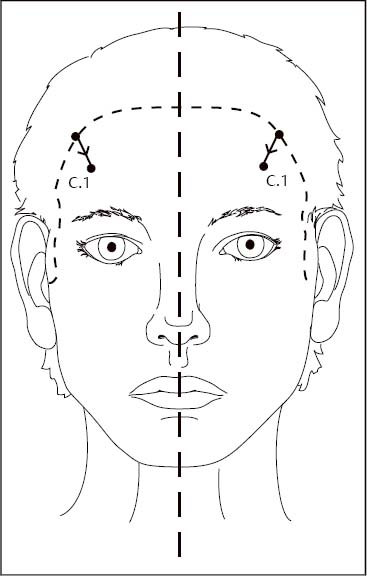
Figure 6–12 Basic point C-1 Yin.

Figure 6–13 Basic point C-1 Yang.
Yin of YANG: On the superior nuchal ridge 1.5 cun lateral to the midline of the occiput, along the lamboidal suture. The line is ~1 cun or ~45mm in length, see Figure 6–13. It is a mirror image of the front Yin of YIN point and runs similarly.
Technique
Palpate the slight ridge or contraction of the areola tissue of the scalp at the hairline. Piqué subcutaneously at a 70 degree angle over the point that correlates to the anatomical part to be treated. Change the angle to 15 degrees to thread the needle along the C-1 line; you may piqué the entire length of the point if needed.
Purpose and Use
All shoulder, arm, and hand pain and dysfunctions. All upper motor and lower motor lesions that affect the shoulder, arm, hand, and fingers: frozen shoulder, and trauma such as dislocation, sprain, fractures, tendonitis, bursitis, rheumatoid arthritis, Parkinson’s disease, multiple sclerosis, circulatory disturbances.
Point C-2
Anatomical Correlate
Ipsilateral: Entire leg from hip to toe joints and related soft tissue structures
Location
Point C-2 is a line of points representing the entire lower extremity.
Yin of YIN: At the hairline, 2.0 cun lateral to the metopic suture or 1.5 cun lateral to the line of point A, see Figures 6–14, 6–15, and 6–16. The C-2 line takes a 30 degree angle from the hairline toward the nari. The point is ~1 cun or ~45mm in length. The hairline correlates to the hip, the knee is one-third of the way down the line on the frontal bone. The ankle and toes are displayed in an externally rotated position correlated down the line on the frontal bone.
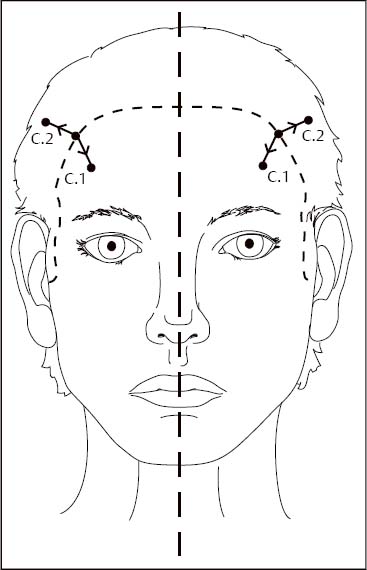
Figure 6–14 Basic point C-1–2 Yin.
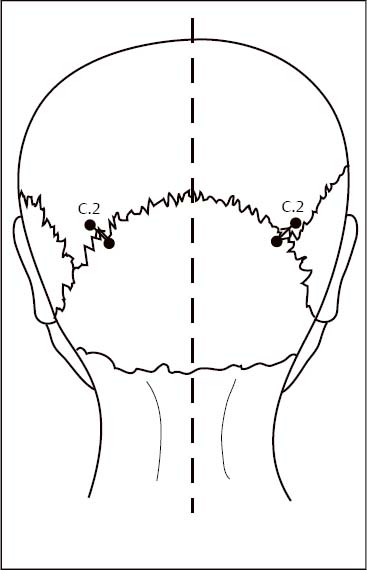
Figure 6–15 Basic point C-2 Yang.
Yin of YANG: On the superior nuchal ridge 1.5 cun lateral to the midline of the occiput.
The point is ~1 cun or ~45mm in length. It is a mirror image of the front Yin of YIN point and runs similarly.
Technique
Palpate the slight ridge or contraction of the areola tissue of the scalp at the hairline. Piqué subcutaneously at a 70 degree angle over the point that correlates to the anatomical part to be treated. Change the angle to 15 degrees to thread the needle along the C-2 line; you may piqué the entire length of the point with one needle if needed.
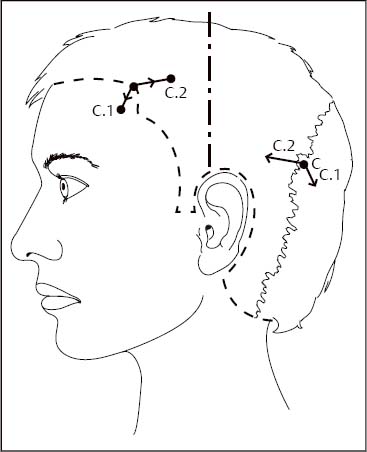
Figure 6–16 Lateral Basic point C-1–2 Yin/Yang.
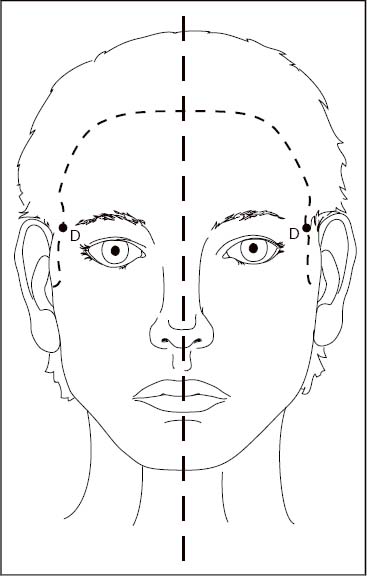
Figure 6–17 Basic point DYin.

Figure 6–18 Basic point DYang.
Purpose and Use
All hip, leg, and foot pain and dysfunctions. All upper motor and lower motor lesions that affect the hip, leg, foot, and toes, trauma, dislocation, sprain, fractures, tendonitis, bursitis, bunions, osteoarthritis, rheumatoid arthritis, Parkinson’s disease, multiple sclerosis, circulatory disturbances.
Point D
Anatomical Correlate
Ipsilateral: Entire lower extremity and lumbar spine
Location
Yin of YIN: at the edge of the hairline, 0.25 cun superior to the zygomatic process of the temporal bone, see Figure 6–17.
Yin of YANG: 1 cun lateral to C-1 along the lambdoidal suture on the occiput. Palpate for a small hill, see Figure 6–18.
Technique
Palpate the slight ridge or contraction of the areola tissue of the scalp at the hairline. Piqué subcutaneously at a 70 degree angle over the point.
Purpose and Use
All lower extremity and lumbar spinal joints and related soft tissue pain and dysfunction. All upper motor and lower motor lesions that affect the lower extremity, hip, knee, foot, and toes: sciatica, lumbago, herniated lumbar disc, neuralgia, neuritis, hemiplegia, paraplegia, trauma, dislocation, sprain, fractures, tendonitis, bursitis, rheumatoid arthritis, Parkinson’s disease, multiple sclerosis, gout, Raynaud’s disease, circulatory disturbances.

Figure 6–19 Basic point D-1–6 Yin.
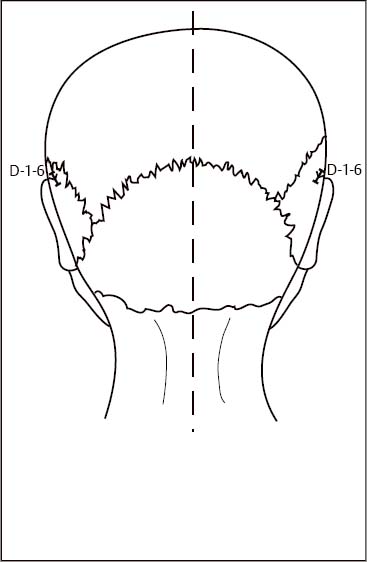
Figure 6–20 Basic point D-1–6 Yang.
Points D-1–6
Anatomical Correlate
Ipsilateral: Entire lumbar spine, soma and neural structures including their related vascular and lymphatic elements. Primarily related to L1–S2 nerve roots and their function. L1 is most superior and coccyx is most caudal in both YIN and YANG quadrants. Lumbar spine vertebrae L1–5 and sacral S1–2 nerve, motor, and sensory distribution affects and effects, L1–5, sacrum, and coccyx, discs, fascia, lumbar musculature, and soft tissue structures of the spine, hips, pelvis, and lower extremity.
Location
Points D-1–6 are a line of points representing all lumbar vertebrae, sacrum and coccyx.
Yin of YIN: at the posterior hairline of the sideburn, 0.5 cun above the zygomatic arch of the temporal bone, in front of the root of the pinna of the ear, see Figure 6–19.
Yin of YANG: at the hairline behind the pinna of the ear, 0.5 cun posterior to the root of the pinna of the ear on the temporal bone, see Figures 6–20 and 6–21. The point is ~3 mm in length.
Technique
Palpate the area just in front of the root of the ear. There is no ridge or hill. Piqué subcutaneously at a 15 degree angle over the point that correlates with the anatomical part to be treated. You may piqué the entire length of the line with one needle if needed.
Purpose and Use
This anatomical point is especially useful when a positive neck diagnosis is made for lumbar spine, but may be used based on known anatomical relationships to the patient’s disease and dysfunction. This point is effective for lumbar pain, dysfunction, and disease, particularly herniated discs.
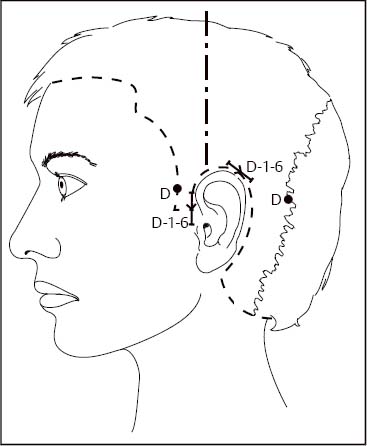
Figure 6–21 Lateral Basic point D and D-1–6 Yin/Yang.
All upper motor and lower motor lesions that affect the lower extremity, hip, knee, foot, and toes: sciatica, lumbago, herniated lumbar disc, neuralgia, neuritis, neuropathy, hemiplegia, paraplegia, trauma, dislocation, sprain, fractures, tendonitis, bursitis, rheumatoid arthritis, Parkinson’s disease, ankylosing spondylitis, multiple sclerosis, gout, Raynaud’s disease, circulatory disturbances.
Points E-1–12
Anatomical Correlate
Ipsilateral: Entire thoracic spine soma and neural structures including their related vascular and lymphatic elements. E-1, connected to T1, is lateral and most superior, whereas E-12 is most medial and inferior in both YIN and YANG positions. The points on the E line relate to the thoracic spine vertebrae T1–12 nerve, motor, and sensory distribution affects and effects, T1–12 discs and fascia, thoracic musculature and soft tissue structures of the spine, trunk, and rib cage.
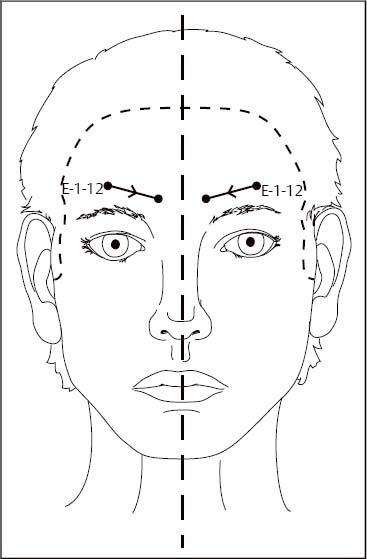
Figure 6–22 Basic point E-1–12 Yin.

Figure 6–23 Basic point E-1–12 Yang.
Location
Points E-1–12 are a line representing thoracic vertebrae 1–12, similar to D-1–6 representing lumbar vertebrae.
Yin of YIN: located above the eyebrow; T12 starts 0.5 cun lateral to the midline above the supra orbital rim. T1 is located lateral at a 15 degree angle 1.75 to ~2 cun, see Figure 6–22.
Yin of YANG: on the occiput under the supraoccipital ridge, T1 is located 1 cun lateral to the midline; points E-1–12 are located moving 1.25 cun superior at a 15 degree angle, see Figure 6–23.
Technique
Palpate the area for tenderness. Piqué subcutaneously at a 15 degree angle over the point that correlates with the anatomical part to be treated. You may piqué the entire length of the point line if needed.
Purpose and Use
This anatomical point is especially useful when a positive neck diagnosis is made for thoracic spine, but may be used based on known anatomical relationships to the patient’s disease and dysfunction. This point is effective for thoracic pain and dysfunction. All upper and lower motor lesions that affect the trunk, herniated thoracic disc, neuralgia, neuritis, neuropathy, hemiplegia, paraplegia, rib and thoracic trauma, dislocation, sprain, fractures, costochondritis, herpes zoster, angina pectoris, dyspnea, asthma, bronchitis, pneumonia, and circulatory disturbances.
Point F
Anatomical Correlate
Ipsilateral: Sciatic nerve.
Location
Only found in the Yang position. Located on the mastoid process, the most protuberant tender point retroauricularly, see Figure 6–24. This point is ~3mm in length.
Technique
Palpate the highest point, little mountain, or contraction of tissue over the mastoid process. Piqué subcutaneously at a 70 degree angle over the point.
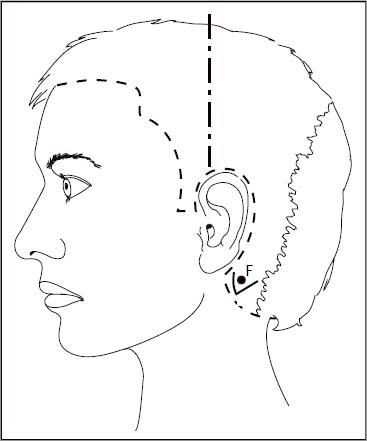
Figure 6–24 Basic point F Lateral.
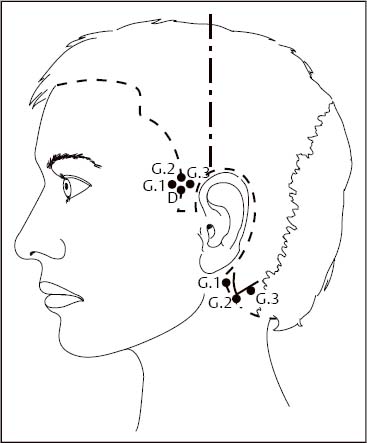
Figure 6–25 Basic point G-1, G-2, and G-3 Lateral.
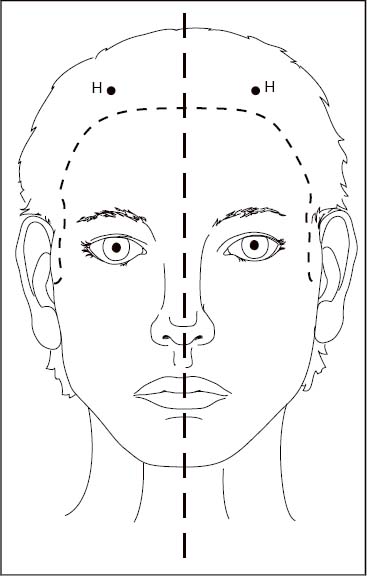
Figure 6–26 Basic point H Yin.
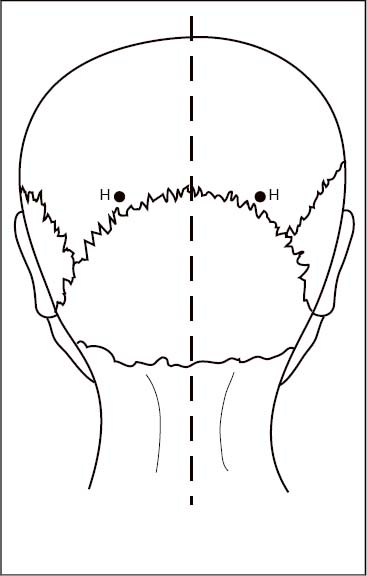
Figure 6–27 Basic point H Yang.
Purpose and Use
This is the principle point for sciatica. Used for sciatica and lumbar radiculopathy.
Points G-1–3
Anatomical Correlate
Ipsilateral: Medial knee is G-1, patella is G-2, and lateral knee is G-3.
Location
Yin of YIN: In a line, G-1 is anterior, G-2 is slightly superior and between G-1 and G-2 G-3 is most posterior. They are ~0.2 cun above points on the D line; see Figure 6–25. Each point is ~2mm in length.
Yin of YANG: On the mastoid process, G-2 is located at the tip of the mastoid at the root of the styloid. G-1 is located 0.5 cun anterior and 0.5 cun superior to G-2. G-3 is located 0.5 cun posterior and 0.5 cun superior to G-2. Each point is ~3mm in length.
Technique
Palpate the edge of the mastoid process, identify the tip, and then piqué the point needed, either G-1–3 or any of three points individually. The point is usually tender to palpation. Piqué subcutaneously at a 70 degree angle over the point.
Purpose and Use
Knee pain, neuralgia, neuritis, bursitis, meniscus tears, sprains, osteoarthritis, chondromalacia of the patella, fracture, capsular sprain, strains, and somatic dysfunction.
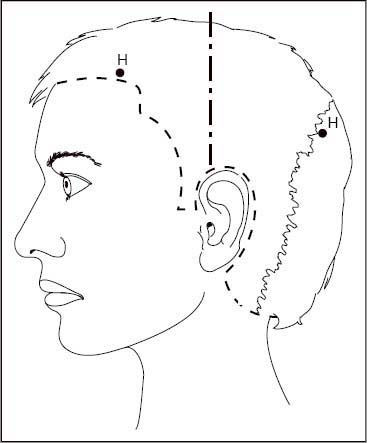
Figure 6–28 Lateral Basic point H Yin/Yang.
Point H
Anatomical Correlate
Ipsilateral: Point H is a supplementary point for lumbar symptomatology. It is not used alone but in conjunction with point D and/or points D-1–6.
Location
Yin of YIN: Caudally ~0.5 cun posterior to B-2. The point is ~3mmin length, see Figure 6–26.
Yin of YANG: Superior ~0.25 cun anterior to B-2. The point is ~3mm in length, see Figures 6–27 and 6–28.
Technique
Palpate the tender high point of the scalp. Piqué subcutaneously at a 70 degree angle over the point.
Purpose and Use
Used in conjunction with basic D and D-1–6 points for unrelenting lumbar symptomatology.
Point I
Anatomical Correlate
Ipsilateral: Point I is a supplementary point for lumbar symptomatology. It is rarely used alone but more commonly in conjunction with point D and/or points D-1–6.
Location
Yin of YIN: Caudally ~1.0 cun behind C-2, see Figure 6–29. The point is ~3mm in length.
Yin of YANG: Superior ~0.5 cun anterior to C-2, see Figures 6–30 and 6–31. The point is ~3mm in length.
Technique
Palpate the tender high point of the scalp. Piqué subcutaneously at a 70 degree angle.
Point J
Anatomical Correlate
Ipsilateral: Point J is a supplementary point for dorsal foot pain. It is rarely used alone but in conjunction with points D and/or C-2 and/or B-2.
Location
Yang of YIN: At the vertex of the head on the parietal bone, 0.5 cun anterior to the transverse line. The point is a little hill, tender to touch, ~3mm in length, see Figure 6–32.
Yang of YANG: At the vertex of the head on the parietal bone, 0.5 cun posterior to the transverse line. The point is a little hill, tender to touch, ~3mm in length.
Technique
Palpate the tender high point of the scalp. Piqué subcutaneously at a 70 degree angle over the point.
Purpose and Use
Used in conjunction with basic C-2, B-2, and/or points on the D line for dorsal foot pain.
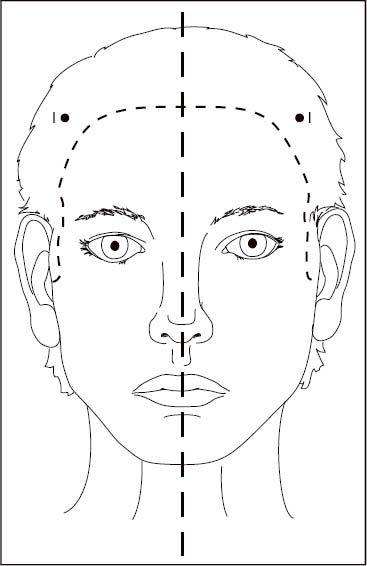
Figure 6–29 Basic point I Yin.
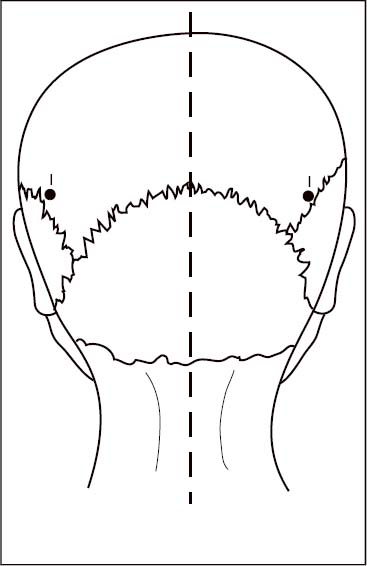
Figure 6–30 Basic point I Yang.
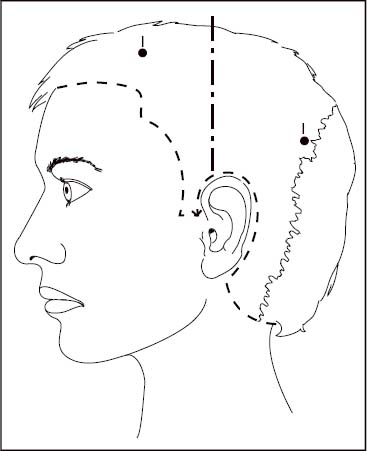
Figure 6–31 Lateral Basic point I Yin/Yang.
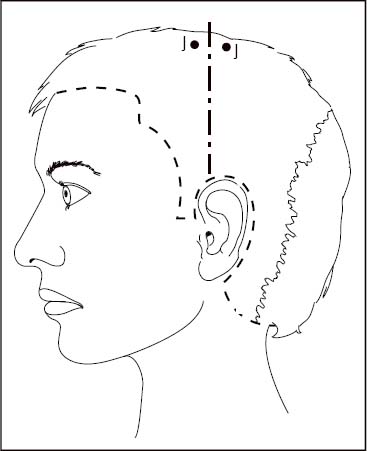
Figure 6–32 Basic point J Yin/Yang.
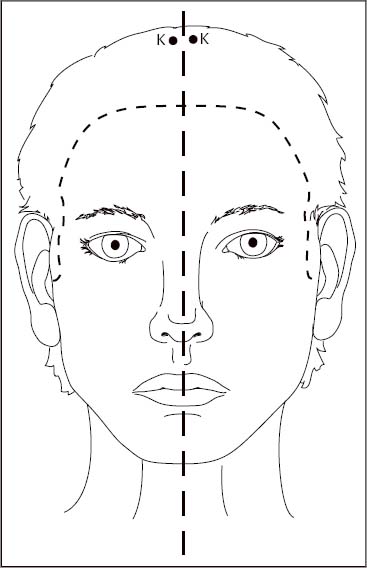
Figure 6–33 Basic point K Yin.
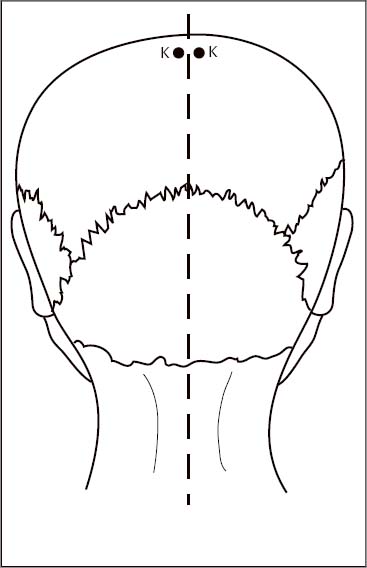
Figure 6–34 Basic point K Yang.
Point K
Anatomical Correlate
Ipsilateral: Point K is a supplementary point for lumbar symptomatology particularly herniated disc. It is rarely used alone but in conjunction with D and/or C-2 and/or points D-1–6.
Location
Yang of YIN: At the vertex of the head on the parietal bone 1 cun anterior to the transverse line. The point is a little hill, tender to touch, ~3mm in length, see Figure 6–33.
Yang of YANG: At the vertex of the head on the parietal bone 1.0 cun posterior to the transverse line, see Figure 6–34. The point is a little hill, tender to touch, ~3mm in length.
Technique
Palpate the tender high point of the scalp. Piqué subcutaneously at a 70 degree angle over the point.
Purpose and Use
This point is used in conjunction with basic D and D-1–6 points for unrelenting lumbar pain and herniated disc.
Points M-1, M-2, and M-3
Anatomical Correlates
Ipsilateral: Points M-1, M-2, and M-3 are named for midline brain points. The basal ganglion is M-1, cranial nerves I-XII and cerebrum are M-2, and cerebellum is M-3.
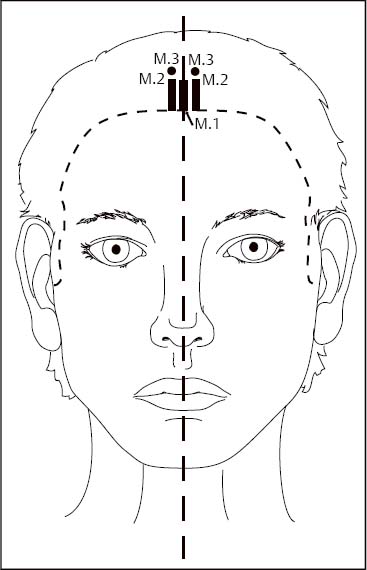
Figure 6–35 Basic points M-1–3 Yin.
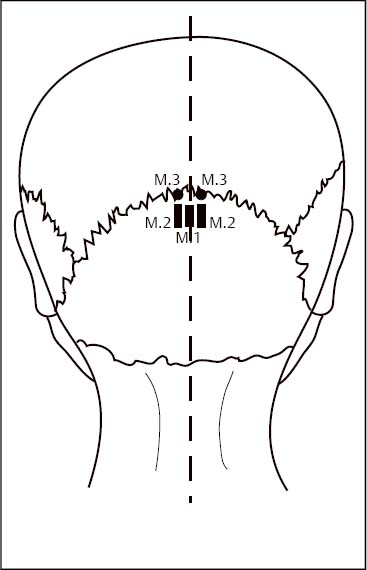
Figure 6–36 Basic points M-1–3 Yang.
Location
Yin of YIN: At the midline of the hairline over the metopic suture going 20mm posteriorly is M-1. M-2 and M-3 are 0.25 cun lateral to the midline. M-2 is at the hairline going posteriorly 20mm. Directly behind M-2 is M-3 going posterior another 10mm, see Figure 6–35.
Yin of YANG: At the midline of the occipital over the external occipital protuberance M-1 goes anterior 15mm. M-2 and M-3 are 0.2 cun lateral to the midline. M-2 starts along the Yin of YANG A-3, B-1, and C-1 line going anteriorly 15mm. Directly superior-anterior to M-2 is M-3, going another 7mm superior anteriorly; see Figure 6–36.
Technique
Palpate the metopic suture over the frontal bone in the midline, identify the suture ridge, and then piqué the M-1 point if needed, based on history, physical findings, and YNSA abdominal and neck diagnosis tenderness for brain point. Move laterally the prescribed fraction of a cun to palpate the little hill for M-2 and M-3. All three points may be taken individually or together, either ipsilaterally or bilaterally. The point usually is tender to palpation. Piqué subcutaneously at a 20 degree angle over the point and thread the needle over the length of the point as needed.
Purpose and Use
All upper and lower motor neuron dysfunctions, hemiplegia, paraplegia, Parkinson’s disease, multiple sclerosis, hormonal dysfunction, migraine, cranial nerve entrapment neuropathies, trigeminal neuralgia, neuritis, neuropathy, vertigo, tinnitus, aphasia, visual changes, epilepsy, insomnia, dementia, depression, attention deficit disorder (ADD), Alzheimer’s disease, fatigue, temporal mandibular joint (TMJ) dysfunction, and tension cephalgia.
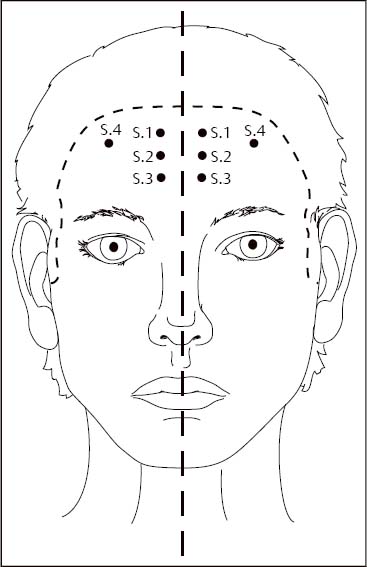
Figure 6–37 Basic points S-1–4 Yin.
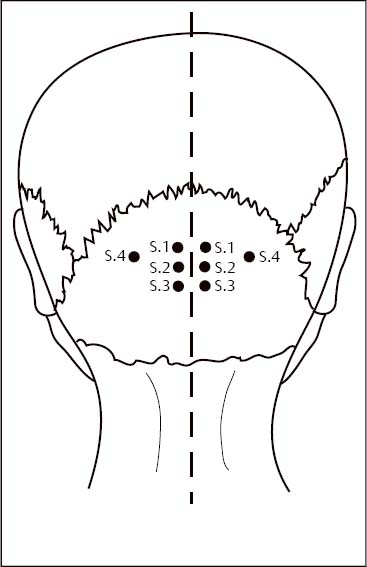
Figure 6–38 Basic points S-1–4 Yang.
Points S-1–4
Anatomical Correlate
Ipsilateral: Points S-1–4 are named for special senses. The eye is S-1, nose is S-2, mouth is S-3, and ear is S-4.
Location
Yin of YIN: S-1 is located 0.5 cun lateral to the midline and 0.5 cun below the hairline. S-2 is located 0.5 cun lateral to the midline and 1 cun below the hairline. S-3 is located 0.5 cun lateral to the midline and 1.5 cun below the hairline. S-4 is located 0.7 cun below the hairline and 0.25 cun medial to the C-1 line, see Figure 6–37. All these points are little hills on palpation, 2 to 3mm in length.
Yin of YANG: On the occiput, S-1 is located ~0.3 cun lateral to the midline and 0.3 cun inferior to the Yang hairline points A-3, B-1, and C-1. Point S-2 is 0.3 lateral to the midline and 0.6 cun inferior from the Yang points A-3, B-1, C-1. S-3 is located 0.3 cun lateral to the midline and 1 cun inferior to the Yang A-3, B-1, and C-1 line. S-4 is located between the S-1 and S-2 points and medial C-1 line, see Figure 6–38. Points S-1–4 are ~2–3mmin length.
Technique
Palpate the little hill; press with fingernail to illicit tenderness. Then piqué the point needed, S-1, S-2, S-3, and S-4, or all four points individually, depending on tenderness to palpation. Piqué subcutaneously at a 70 degree angle over the point(s).
Purpose and Use
• S-1 eye point: impaired vision, glaucoma, ocular pain, conjunctivitis esophoria and exophoria, strabismus sprain, strains, and somatic dysfunction, pre- and postoperative ocular pain.
• S-2 nose point: asnomia, rhinitis, sinusitis, allergic conditions, nasal obstruction, somatic dysfunction, pre- and postoperative nasal procedures.
• S-3 mouth point: aphasia, tooth and gum pain, stomatitis, herpes simplex, tonsillitis, pharyngitis, somatic dysfunction, temporal mandibular joint pain, pre- and postoperative oral pain.
• S-4 ear point: otitis media, otitis externa, tinnitus, somatic dysfunction, pre- and postoperative otic pain.
Stay updated, free articles. Join our Telegram channel

Full access? Get Clinical Tree








